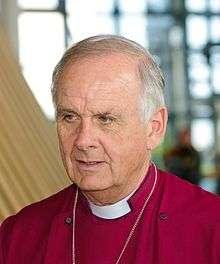Archbishop of Wales
| Archbishop of Wales | |
|---|---|
| Archbishopric | |
| anglican | |
 | |
|
Incumbent: Barry Morgan | |
| Province | Church in Wales |
| First incumbent | Alfred Edwards |
| Formation | 1920 |
The post of Archbishop of Wales was created in 1920 when the Church in Wales was separated from the Church of England (of which the four Welsh dioceses had previously been part), and disestablished. The new Church became the Welsh province of the Anglican Communion.
Unlike the Archbishops of Canterbury and York, who are appointed by the Queen upon the advice of the Prime Minister, the Archbishop of Wales is one of the six diocesan bishops of Wales, elected to hold this office in addition to his own diocese.
With the establishment of the new province, there was debate as to whether a specific see should be made the primatial see, or if another solution should be adopted. Precedents were sought in the early history of Christianity in Wales, with St David's having a debatable pre-eminence among the sees. A Roman Catholic Archbishopric of Cardiff had been created in 1916. Instead it was decided that one of the diocesan bishops should hold the title Archbishop of Wales in addition to his own see. The circulating character of the post was justified by Welsh geography and by the ecclesiastical precedent of the province of Numidia (of which St. Augustine of Hippo had been a bishop). The Archbishop is chosen in Llandrindod Wells, being a central point in the Country. The first Archbishop was chosen in the Old Parish Church in Llandrindod, but in more recent years, Holy Trinity Church has been used.
Successive archbishops have not only represented different geographical areas but also different tendencies within Anglicanism. In the mid-twentieth century linguistic issues were prominent in the successive incumbencies of Edwin Morris (who spoke no Welsh) and of Glyn Simon (who sympathised with advocates of the use of the Welsh language). Morris in some ways represented the broad churchmanship characteristic of the first occupant of the newly created post, Alfred Edwards, whereas Simon in many respects inherited the Anglo-Catholic outlook of the second archbishop, Charles Green (but without his authoritarianism). Towards the end of his period in office Gwilym Williams was one of three leading Welsh figures in a deputation to guarantee the status of the language which had been challenged by Margaret Thatcher. He was also decisive in the decision to ordain women priests. The former Archbishop of Canterbury, Rowan Williams, now Master of Magdalene College, Cambridge, was Archbishop of Wales and Bishop of Monmouth.
The current Archbishop of Wales is Barry Morgan, who signs 'Barry Cambrensis'.
List of Archbishops of Wales
| Archbishops of Wales | |||
|---|---|---|---|
| From | Until | Incumbent | Notes |
| 1920 | 1934 | Alfred Edwards | Also Bishop of St Asaph from 1889. |
| 1934 | 1944 | Charles Green | Previously Bishop of Monmouth; also Bishop of Bangor from 1928; died in office. |
| 1944 | 1949 | David Prosser | Also Bishop of St David's from 1926. |
| 1949 | 1957 | John Morgan | Previously Bishop of Swansea and Brecon; also Bishop of Llandaff from 1939; died in office. |
| 1957 | 1967 | Edwin Morris | Also Bishop of Monmouth from 1945. |
| 1968 | 1971 | Glyn Simon | Previously Bishop of Swansea and Brecon; also Bishop of Llandaff from 1957. |
| 1971 | 1982 | Gwilym Williams | Also Bishop of Bangor from 1957. |
| 1983 | 1986 | Derrick Childs | Also Bishop of Monmouth from 1972. |
| 1987 | 1991 | George Noakes | Also Bishop of St David's from 1982. |
| 1991 | 1999 | Alwyn Rice Jones | Also Bishop of St Asaph from 1982. |
| 1999 | 2002 | Rowan Williams | Also Bishop of Monmouth from 1992; translated to Canterbury. |
| 2003 | present | Barry Morgan | Previously Bishop of Bangor; also Bishop of Llandaff since 1999. Retirement announced for 31 January 2017.[1] |
| Source(s):[2][3] | |||
References
- ↑ Church in Wales — Archbishop of Wales to retire in January (Accessed 26 August 2016)
- ↑ "Historical successions: Archbishops of Wales". Crockford's Clerical Directory. Retrieved 17 July 2012.
- ↑ "Previous Archbishops of Wales". Church in Wales. Retrieved 17 July 2012.